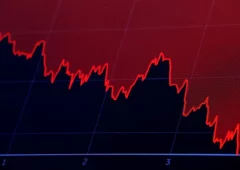Billionaire Ray Dalio Warns of U.S. Debt Crisis, Calls for Urgent Action
16.02.2025 20:00 2 min. read Kosta Gushterov
Billionaire investor Ray Dalio has issued a stark warning about the U.S. economy, suggesting that the country is heading toward a dangerous "debt death spiral" due to its growing fiscal deficits.
Speaking in a CNBC interview, the Bridgewater Associates founder explained that a healthy credit system benefits all participants, from borrowers to lenders, as long as debt is used productively to generate income.
However, he believes the U.S. government is now borrowing at an unsustainable pace, potentially outstripping demand from buyers. This could force the government to take on more debt just to cover existing obligations, a scenario that Dalio says could spiral out of control.
He compares the situation to a clogged circulatory system, where excessive debt functions like plaque restricting blood flow. With interest payments alone approaching $1 trillion annually, the ability to allocate funds elsewhere is becoming increasingly constrained.
Dalio also highlights a critical supply-and-demand imbalance in the credit markets. With the U.S. deficit projected at around 7.5% of GDP, the government must sell a significant amount of debt to cover its shortfall. But if investor appetite fails to keep pace, the situation could deteriorate rapidly. He describes this as a classic debt cycle where borrowing becomes self-perpetuating, leading investors to lose confidence and offload government debt—pushing the system closer to collapse.
To prevent a full-blown crisis, Dalio argues that the U.S. must take decisive action by reducing its deficit to 3% of GDP, a strategy he calls “the 3% solution.” Achieving this, he says, would require both spending cuts and lower interest rates. He warns that failure to implement these measures could lead to dire consequences, urging political leaders to take responsibility before it’s too late.
-
1
Here is Why the Fed May Cut Rates Earlier Than Expected, According to Goldman Sachs
08.07.2025 15:00 2 min. read -
2
What Brian Armstrong’s New Stats Reveal About Institutional Crypto Growth
29.06.2025 15:00 2 min. read -
3
Donald Trump Signs “One Big Beautiful Bill”: How It Can Reshape the Crypto Market
05.07.2025 9:56 2 min. read -
4
Market Odds of a U.S. Recession in 2025 Drop in Half Since May
05.07.2025 18:30 2 min. read -
5
Toncoin Launches UAE Golden Visa Program Through $100,000 Staking Offer
06.07.2025 12:04 2 min. read
U.S. Public Pension Giant Boosts Palantir and Strategy Holdings in Q2
According to a report by Barron’s, the Ohio Public Employees Retirement System (OPERS) made notable adjustments to its portfolio in Q2 2025, significantly increasing exposure to Palantir and Strategy while cutting back on Lyft.
Key Crypto Events to Watch in the Next Months
As crypto markets gain momentum heading into the second half of 2025, a series of pivotal regulatory and macroeconomic events are poised to shape sentiment, liquidity, and price action across the space.
Here is Why Stablecoins Are Booming, According to Tether CEO
In a recent interview with Bankless, Tether CEO Paolo Ardoino shed light on the growing adoption of stablecoins like USDT, linking their rise to global economic instability and shifting generational dynamics.
U.S. Dollar Comes Onchain as GENIUS Act Ushers in Digital Era
In a statement that marks a major policy shift, U.S. Treasury Secretary Scott Bessent confirmed that blockchain technologies will play a central role in the future of American payments, with the U.S. dollar officially moving “onchain.”
-
1
Here is Why the Fed May Cut Rates Earlier Than Expected, According to Goldman Sachs
08.07.2025 15:00 2 min. read -
2
What Brian Armstrong’s New Stats Reveal About Institutional Crypto Growth
29.06.2025 15:00 2 min. read -
3
Donald Trump Signs “One Big Beautiful Bill”: How It Can Reshape the Crypto Market
05.07.2025 9:56 2 min. read -
4
Market Odds of a U.S. Recession in 2025 Drop in Half Since May
05.07.2025 18:30 2 min. read -
5
Toncoin Launches UAE Golden Visa Program Through $100,000 Staking Offer
06.07.2025 12:04 2 min. read


